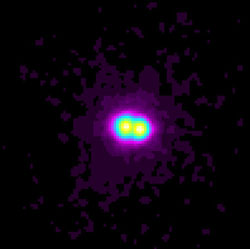September 6, 2001
GSFC Press Release
There's a simple reason why a curious neutron star in the M15 globular star cluster has shown two faces over the years, beaming an X-ray portrait as perplexing as Mona Lisa's smile. The reason: That's not one star system, but two.
Scientists at NASA Goddard Space Flight Center in Greenbelt, Md., capitalized on the exquisite resolution afforded by the Chandra X-ray Observatory to find a second neutron-star binary source just a hair west of the first binary source. The sources had blended together in all earlier observations.
The broader implication of the Chandra discovery is that these types of binaries (a neutron star orbiting another star) can be quite common in star clusters, as was theorized but never observed. Drs. Nicholas White and Lorella Angelini of Goddard's Laboratory for High Energy Astrophysics present their findings today in Washington, D.C., at a conference entitled "Two Years of Science with Chandra".
"We had long assumed there should be more of these neutron star binary systems, and now we are finally finding them," says White. "Past observations of M15, seemingly contradictory, also now make sense in retrospect. The first neutron star is coy, completely hiding behind the swirl of gas that is falling on to it. The second neutron star is prone to outbursts in X-ray light that reveal the star's surface."
Previously, and inexplicably, astronomers had never seen more than one of these neutron star binaries, called low-mass X-ray binaries, in any given globular cluster, a tight spherical region crowded with stars. M15, a beautiful display containing over a million stars, is one of the largest globular clusters, located in the constellation Pegasus some 34,000 light years from Earth.
Astronomers discovered one neutron star system in M15, called 4U2127, with the Einstein X-ray satellite in 1984. Characteristic of a low-mass X-ray binary, 4U2127 contains a city-sized neutron star orbiting a "living" hydrogen-burning star slightly smaller than our Sun, named AC211. Escaped gas from AC211 falls onto the neutron star, attracted by its strong center of gravity. The transfer of gas, called an accretion disk, glows hot in X rays.
The data revealed that the neutron star itself was not directly visible in X-ray light because it was hidden behind the accretion disk. This neat picture was put into doubt when the Japanese Ginga X-ray satellite saw luminous X-ray bursts from the region in 1990. The length of the burst and other light characteristics implied that the surface of the neutron star was directly visible, a complete contradiction to earlier observations.
Using Chandra's HETGS instrument, White and Angelini observed the region for nearly six hours on August 24, 2000. Chandra is capable of 0.5 arcsecond imaging resolution, several times sharper than Einstein.
White and Angelini discovered that what was thought to be one X-ray source is really two sources separated by 2.7 arcseconds. (The distance across Mars, from our vantage point on Earth, forms an angle of about 5 arcseconds. So imagine a gap smaller than that pinpoint of light from Mars.) The new X-ray source, which they dubbed M15-X2, is likely a neutron star orbiting a faint blue star, Angelini said.
Globular clusters, with their myriad stars, should contain several low-mass X-ray binary systems. The fact that there was never more than one seen in any globular cluster, including the massive M15, led some theorists to speculate that these binaries are short-lived. Or, perhaps neutron stars -- created from burned-out, collapsed stars during supernova explosions -- are ejected from globular clusters with a thunderous kick as the neutron stars forms.
The Chandra observation has eliminated the need for such elaborate scenarios. M15 has at least two low-mass X-ray binary systems, and perhaps multiple systems in other cluster will be discovered given advancements in X-ray resolution. Indeed, M15 also has many radio pulsars, which may be the remnants of low-mass X-ray binary systems.
Angelini joins NASA Goddard through the University Space Research Association. The Chandra HETGS, or High Energy Transmission Grating Spectrometer, was built by the Massachusetts Institute of Technology.
For images of M15, refer to http://www.gsfc.nasa.gov/topstory/20010906twofaced.html.



